Genre: Shmup Developer: ISCO Publisher: Asmik Players: 1 Released: 1991
Almost every shmup has one key gameplay mechanic that sets it apart from others. Be it the ability to direct your shot in any direction or to manipulate your options, almost anything that offered a unique approach to the way you played made a shmup at least moderately fun. Often, they became sought after and adorned with praise. For example, R-Type offered the creative use of the Force Pod, and Gleylancer allowed you to control your options (or movers, as they were called).
… and Verytex has… Verytex has… er… hmmm. What does Verytex have?
Well, next to nothing.
That’s right. Verytex is as bare bones as a shooter can get. Three twice upgradeable weapons (the currently commonplace spread, laser, and wave), homing missiles, three (bullet) hit shields, up to six bombs and three ship speeds. That’s it. “shmup: Lesson One.” There’s no shape shifting ship a la Macross, or an Axelay-style weapon loss when hit; not even colour shifting to absorb same coloured bullets like in Ikaruga.
Here’s your ship and there are the enemies, now go shoot them.
Throughout the six levels that lie ahead of you, this principle is maintained in ALMOST every aspect of the game. As for the gameplay, you don’t even have an options menu. You can just start off, or you can endlessly continue on the level where you lost your last life. The A button lets you shoot, the B button detonates the age-old screen clearing bomb – provided you have them – and the C button toggles your ship’s speed. The weapon upgrading follows the the Raiden concept: the weapon upgrades if you obtain a power-up of your current weapon. It’s not exactly oozing originality there, is it?
The behavior of the enemies is similarly textbook: encircling, coming down in an N-pattern, swirling down, appear-shoot-disappear (strike) and of course, homing into you. In the first five levels, you encounter a mini boss and a boss at the end of the level. Mini bosses, however, are pathetically easy to take out. With fully upgraded weapons and missiles, mini bosses take no more than 10 to 15 seconds to beat. Bosses are a fair bit harder and have mostly three stages of attack. Nevertheless, the attacks are quite transparent and with a few tries, you’ll have their attack pattern figured out and they’ll be easy to dispose of.
The same basic feel applies for the graphics. Your ship is just what it is. A ship. Save for a few hints of shadow and lighting, it’s as basic as you can get. The ship has one animation frame for steering in each direction, and just two frames for the shield. The enemies are equally unoriginal, basic and barely animated, nothing you haven’t seen before, better. Surprisingly, the backgrounds are a fresh deviation from the Verytex norm. They’re just plain drab.
The few sound effects that are there are again trademark Verytex minimalist. Your shots, aside from the laser, are barely audible, and most of the explosions are, while nicely loud, nothing special. Enemy shots are for the most part silent, except for the greater enemy lasers, which sound loud and fairly impressive.
Now, for the cliché dramatic question: is there nothing that can give Verytex even a little bit of polish? In all fairness, there is. The currently quite famous Hitoshi Sakimoto and Masaharu Iwata – more cryptically known as YmoHS and Rezon in the game – together with a certain JKL Furukawa, have composed the music of Verytex, and it shows (sounds?). After a somewhat less than stellar intro theme, the music of the first level picks it up and actually sucks you up into the action with energetic melodies and tones. The rest of the in-game music mostly maintains this trend and enliven the otherwise quite unimpressive ordeal. Although the compositions here aren’t the most inspired of music compositions (Sakimoto and Iwata did much better themselves in another Genesis game, Gauntlet IV), they certainly outshine the music of most of the other shooters, even if there are just ten tracks, a game over- and a level clear-jingle. I actually paused the game just to listen to the music that just keeps on playing when paused. I wish it had a sound test.
The final boss deserves special mention though, and not in a good way. After you’ve dealt with its first two incarnations, it decides to go awry on you, by letting a total of three gigantic eyes shoot massive lasers in your general direction while firing down a wave of flames, some of which home in on your ship. It will severely beat you around several times over. Back to the start of level 6, actually. To say this is unfair, is the understatement of the year, were it not that there is a way of beating it easily, without cheating.
Once you – finally – found the way to gun all of its eyes down, you are treated to what I think is the single worst ending next to “Congratulation.” A paragraph in Japanese, which I reckon is the climactic story of your efforts, scrolls up, followed by the credits in English. There are no pictures to be beheld, nor are there any features to unlock – none that I’ve found at least, nothing. After your more than frustrating battle with the final boss, this is, politely said, kind of a letdown.
All in all, Verytex has ‘basic’ written all over it, and hadn’t it for the amazingly effective and energetic tunes, Verytex would be flat out boring. On the other hand, it doesn’t pretend to be more than it is. It’s a shooter. We’ve seen it before, but nonetheless, it’s a shooter. No gimmicks or outrageous gameplay tricks, just go shoot them, and honestly, that’s what all shooters boil down to in one way or the other. Negative remarks aside, Verytex still makes for a nice, lazy weekend’s diversion from the video game rental or the bargain bin.
SCORE: 5 out of 10


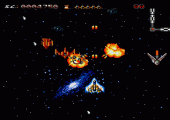
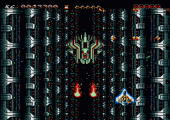
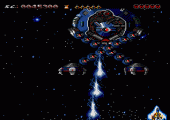
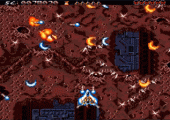
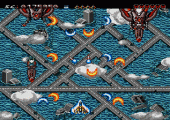
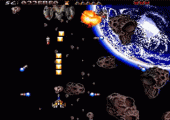

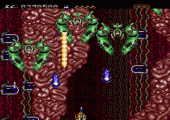
Recent Comments